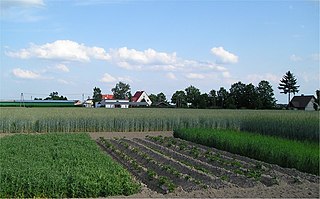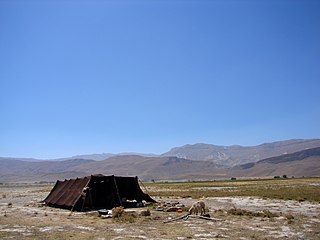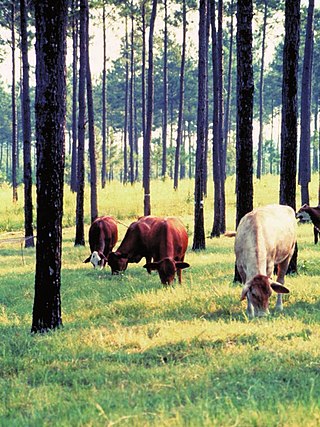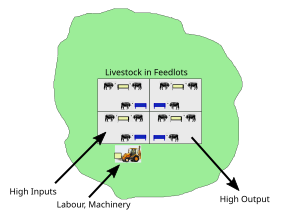
Crop rotation is the practice of growing a series of different types of crops in the same area across a sequence of growing seasons. This practice reduces the reliance of crops on one set of nutrients, pest and weed pressure, along with the probability of developing resistant pests and weeds.

Intensive agriculture, also known as intensive farming, conventional, or industrial agriculture, is a type of agriculture, both of crop plants and of animals, with higher levels of input and output per unit of agricultural land area. It is characterized by a low fallow ratio, higher use of inputs such as capital, labour, agrochemicals and water, and higher crop yields per unit land area.

Pasture is land used for grazing.

The following outline is provided as an overview of and topical guide to organic gardening and farming:
Natural Resources Conservation Service (NRCS), formerly known as the Soil Conservation Service (SCS), is an agency of the United States Department of Agriculture (USDA) that provides technical assistance to farmers and other private landowners and managers.

In agriculture, grazing is a method of animal husbandry whereby domestic livestock are allowed outdoors to free range and consume wild vegetations in order to convert the otherwise indigestible cellulose within grass and other forages into meat, milk, wool and other animal products, often on land that is unsuitable for arable farming.

Nutrient management is the science and practice directed to link soil, crop, weather, and hydrologic factors with cultural, irrigation, and soil and water conservation practices to achieve optimal nutrient use efficiency, crop yields, crop quality, and economic returns, while reducing off-site transport of nutrients (fertilizer) that may impact the environment. It involves matching a specific field soil, climate, and crop management conditions to rate, source, timing, and place of nutrient application.

Pastoralism is a form of animal husbandry where domesticated animals are released onto large vegetated outdoor lands (pastures) for grazing, historically by nomadic people who moved around with their herds. The animal species involved include cattle, camels, goats, yaks, llamas, reindeer, horses, and sheep.

Agricultural wastewater treatment is a farm management agenda for controlling pollution from confined animal operations and from surface runoff that may be contaminated by chemicals in fertilizer, pesticides, animal slurry, crop residues or irrigation water. Agricultural wastewater treatment is required for continuous confined animal operations like milk and egg production. It may be performed in plants using mechanized treatment units similar to those used for industrial wastewater. Where land is available for ponds, settling basins and facultative lagoons may have lower operational costs for seasonal use conditions from breeding or harvest cycles. Animal slurries are usually treated by containment in anaerobic lagoons before disposal by spray or trickle application to grassland. Constructed wetlands are sometimes used to facilitate treatment of animal wastes.

Silvopasture is the practice of integrating trees, forage, and the grazing of domesticated animals in a mutually beneficial way. It utilizes the principles of managed grazing, and it is one of several distinct forms of agroforestry.

Cytisus proliferus, tagasaste or tree lucerne, is a small spreading evergreen tree that grows 3–4 m (10–13 ft) high. It is a well known fertilizer tree. It is a member of the Fabaceae (pea) family and is indigenous to the dry volcanic slopes of the Canary Islands, but it is now grown in Australia, New Zealand and many other parts of the world as a fodder crop.

The environmental impacts of animal agriculture vary because of the wide variety of agricultural practices employed around the world. Despite this, all agricultural practices have been found to have a variety of effects on the environment to some extent. Animal agriculture, in particular meat production, can cause pollution, greenhouse gas emissions, biodiversity loss, disease, and significant consumption of land, food, and water. Meat is obtained through a variety of methods, including organic farming, free-range farming, intensive livestock production, and subsistence agriculture. The livestock sector also includes wool, egg and dairy production, the livestock used for tillage, and fish farming.
Range Condition Scoring was developed as a way to quantify biodiversity in a given rangeland system. This practice is widely used in the Sand Hills region of Nebraska, as well as the tallgrass prairie regions, as evidenced by the authoritative book on the subject, "Range Judging Handbook and Contest Guide for Nebraska." This book outlines the steps required to evaluate, or score, a particular region of rangeland; and it serves as a baseline for the understanding of this method of judging rangeland health.

Agricultural pollution refers to biotic and abiotic byproducts of farming practices that result in contamination or degradation of the environment and surrounding ecosystems, and/or cause injury to humans and their economic interests. The pollution may come from a variety of sources, ranging from point source water pollution to more diffuse, landscape-level causes, also known as non-point source pollution and air pollution. Once in the environment these pollutants can have both direct effects in surrounding ecosystems, i.e. killing local wildlife or contaminating drinking water, and downstream effects such as dead zones caused by agricultural runoff is concentrated in large water bodies.
The concept of an animal unit (AU) has traditionally been used in North America to facilitate planning, analysis and administration of forage use by grazing livestock, but the term has also had other applications. The term has been variously defined by regulation in different jurisdictions, and by livestock management specialists, rangeland resource managers and others. Consequently, when using or interpreting the term, care is needed to ensure that a definition appropriate for the purpose is being used. Most definitions are based on the concept that a 1000-pound (454 kg) cow, with or without an unweaned calf, is one animal unit, with such a cow being assumed to consume 26 pounds of forage dry matter per day.

Holistic Management in agriculture is an approach to managing resources that was originally developed by Allan Savory for grazing management., Holistic Management has been likened to "a permaculture approach to rangeland management". Holistic Management is a registered trademark of Holistic Management International. It has faced criticism from many researchers who argue it is unable to provide the benefits claimed.

Chamaecrista rotundifolia, the round-leaf cassia, also known as pasto rastiero, roundleaf sensitive pea, and Wynn cassia, is a short-lived perennial or self-generating annual plant in the subfamily Caesalpinioideae of the family Fabaceae. It originated in North America, Mesoamerica, the Caribbean, and Tropical South America but is grown in other parts of the world today. It grows in dry soils and areas of low rainfall, as well as in low-fertility and acidic soils with high levels of solubilized aluminum. It can also reduce erosion and runoff over time. These factors make it a potential asset to farmers in the African Subtropics and elsewhere where soil quality is a barrier to farming. It serves as a source of feed for livestock and acts as a green fertilizer, raising soil quality and nutrient content which can improve yields. These combined benefits make round-leaf cassia a potential solution to many problems faced by poor farmers and their communities.

Regenerative agriculture is a conservation and rehabilitation approach to food and farming systems. It focuses on topsoil regeneration, increasing biodiversity, improving the water cycle, enhancing ecosystem services, supporting biosequestration, increasing resilience to climate change, and strengthening the health and vitality of farm soil.
The production of cattle has a significant environmental impact, whether measured in terms of methane emissions, land use, consumption of water, discharge of pollutants, or eutrophication of waterways.
This glossary of agriculture is a list of definitions of terms and concepts used in agriculture, its sub-disciplines, and related fields, including horticulture, animal husbandry, agribusiness, and agricultural policy. For other glossaries relevant to agricultural science, see Glossary of biology, Glossary of ecology, Glossary of environmental science, and Glossary of botanical terms.


















